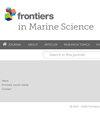High potential microbial denitrification in non-hypoxic intermediate waters of the South China Sea basin
IF 3
2区 生物学
Q1 MARINE & FRESHWATER BIOLOGY
引用次数: 0
Abstract
IntroductionThe discovery of microbial denitrification in non-extreme oxygen-deficient environments has drawn growing attention. At the same time, it is reshaping previous understanding of the spatial pattern of marine nitrogen (N) sinks. The non-hypoxic subsurface and intermediate waters of the South China Sea (SCS) basin possess potential favorable conditions for the occurrence of microbial denitrification, which are long-term overlooked and remained unexplored.MethodsMethods: In this study, a series of南海海盆非缺氧中间水体的高潜力微生物反硝化作用
在非极端缺氧环境中微生物反硝化作用的发现引起了越来越多的关注。同时,它正在重塑以往对海洋氮汇空间格局的认识。南海海盆非缺氧地下和中层水体具有微生物反硝化作用发生的潜在有利条件,但长期以来被忽视和未被开发。方法:本研究采用15n同位素示踪剂系列培养实验,结合功能基因表征和水化学参数分析,在巡航过程中进行。进行了严格的统计分析,以揭示环境变量与反硝化活性之间的相关性。结果表明,具有代表性的反硝化功能基因(narG和nirS)在水体中普遍存在,丰度适中(0.1×104~12×105 copies/L)。在溶解氧(DO)饱和度较低(20%~30%)的中间水域(600~1500 m),原位反硝化速率较弱(0.2~1.1 nmol N2/L/d)。然而,在模拟缺氧条件下,大多数采样层都检测到活性反硝化,其潜在速率(0.2~33 nmol N2/L/d)与典型缺氧区(ODZs)相当。悬浮颗粒物(SPM)与颗粒有机碳(POC)含量、反硝化速率和功能基因丰度均呈显著相关。由此推断,低环境DO水平和低氧微生态位可能共同驱动了流域水体反硝化的发生。此外,颗粒物在影响流域反硝化代谢活性和空间变异性方面起着关键作用。由于南海盆地中水承受着来自陆地输入和水动力的大量颗粒负荷,因此可能在水体中保持较强的反硝化潜力。我们进一步提出了复杂环境动力学驱动的颗粒迁移与微生物N去除之间耦合的初步框架。我们的研究不仅为重新评估南海盆地氮预算的需求提供了潜在的意义,而且为非缺氧海洋环境中微生物氮去除的机制解释提供了新的视角。
本文章由计算机程序翻译,如有差异,请以英文原文为准。
求助全文
约1分钟内获得全文
求助全文
来源期刊

Frontiers in Marine Science
Agricultural and Biological Sciences-Aquatic Science
CiteScore
5.10
自引率
16.20%
发文量
2443
审稿时长
14 weeks
期刊介绍:
Frontiers in Marine Science publishes rigorously peer-reviewed research that advances our understanding of all aspects of the environment, biology, ecosystem functioning and human interactions with the oceans. Field Chief Editor Carlos M. Duarte at King Abdullah University of Science and Technology Thuwal is supported by an outstanding Editorial Board of international researchers. This multidisciplinary open-access journal is at the forefront of disseminating and communicating scientific knowledge and impactful discoveries to researchers, academics, policy makers and the public worldwide.
With the human population predicted to reach 9 billion people by 2050, it is clear that traditional land resources will not suffice to meet the demand for food or energy, required to support high-quality livelihoods. As a result, the oceans are emerging as a source of untapped assets, with new innovative industries, such as aquaculture, marine biotechnology, marine energy and deep-sea mining growing rapidly under a new era characterized by rapid growth of a blue, ocean-based economy. The sustainability of the blue economy is closely dependent on our knowledge about how to mitigate the impacts of the multiple pressures on the ocean ecosystem associated with the increased scale and diversification of industry operations in the ocean and global human pressures on the environment. Therefore, Frontiers in Marine Science particularly welcomes the communication of research outcomes addressing ocean-based solutions for the emerging challenges, including improved forecasting and observational capacities, understanding biodiversity and ecosystem problems, locally and globally, effective management strategies to maintain ocean health, and an improved capacity to sustainably derive resources from the oceans.
 求助内容:
求助内容: 应助结果提醒方式:
应助结果提醒方式:


